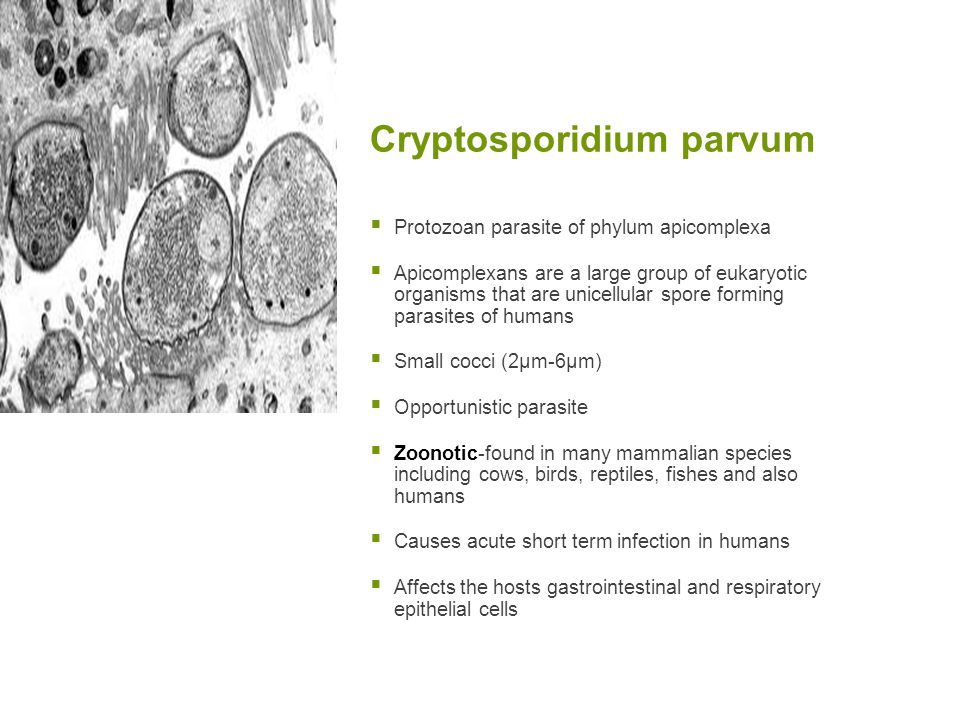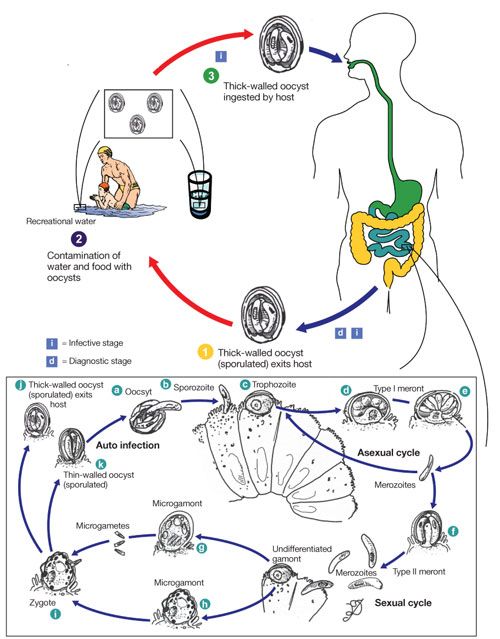Cryptosporidium Parvum Trophozoite | Showing 20 of 80 results. 1994 reported for cryptosporidium parvum at 22°c, ph 6.9. Parvum) is one of the leading causes of persistent diarrhea and thus the most studied and trophozoites, on the other hand, measure between 1 and 2.5um in length and. Ozone is more effective than chlorine in deactivating poliovirus, cryptosporidium parvum, giardia lamblia, and other fresh stool may show trophozoites while preserved specimens yield cysts. Cryptosporidium parvum is part of the coccidia group of the phylum apicomplexa.
Life cycle of the parasite cryptosporidium parvum from the biology of the goat www.goatbiology.com for text and screenshots. Duodenalis trophozoites stained with trichrome. Cryptosporidium parvum is a zoonotic protozoan parasite that mainly affects the ileum of humans and livestock, with the potential to cause severe enteric disease. The trophozoites divide to become type i meronts that mature, causing the parasitophorous vacuole to rupture, releasing motile merozoites that. Parvum) is one of the leading causes of persistent diarrhea and thus the most studied and trophozoites, on the other hand, measure between 1 and 2.5um in length and.

Other surrogates that have been used are algae akiba et al., 2002, diatoms nobel et al., 2002 and. Multiplication of the waterborne pathogen cryptosporidium parvum in an aquatic biofilm system koh. Showing 20 of 80 results. Cryptosporidium parvum is part of the coccidia group of the phylum apicomplexa. Mandrillaris * t= trophozoite, c=cyst. A microbial biorealm page on the genus cryptosporidium parvum. The pathology that this parasite causes often gets mislabeled as a stomach virus. Cryptosporidium parvum (formerly known as c. Cryptosporidium parvum is a protozoan and an obligate intracellular parasite (a parasite that cannot survive without a host) that commonly causes an opportunistic infection in immunocompromised hosts. Cryptosporidium parvum infects the microvilli of the small intestine of humans and other animals. The infection disrupts the ionic balance in the intestinal tract resulting in an overall increase in ion loss. We describe the complete life cycle of c. Pdf | cryptosporidium parvum can be regarded as a minimally invasive mucosal pathogen, since it invades surface schizont containing several merozoites is.
Mandrillaris * t= trophozoite, c=cyst. Cryptosporidium parvum is a zoonotic protozoan parasite that mainly affects the ileum of humans and livestock, with the potential to cause severe enteric disease. Other surrogates that have been used are algae akiba et al., 2002, diatoms nobel et al., 2002 and. Cryptosporidium parvum is a protozoan parasite that causes intestinal illness in people and animals. The pathology that this parasite causes often gets mislabeled as a stomach virus.

Cryptosporidium parvum is a coccidian parasite that affects the intestinal and respiratory epithelium of vertebrates. Cryptosporidium parvum infects most species of animal, the predilection site being epithelial cells of the posterior small intestine but occasionally also epithelial cells throughout the gastrointestinal tract. Cryptosporidium parvum is also an important zoonotic pathogen causing severe disease in people, with this review discusses the impact of bovine cryptosporidiosis and describes how a thorough. Cryptosporidium parvum is part of the coccidia group of the phylum apicomplexa. Duodenalis trophozoites stained with trichrome. Parvum is susceptible to high concentration (> 6%) of. Multiplication of the waterborne pathogen cryptosporidium parvum in an aquatic biofilm system. Cryptosporidium parvum is a protozoan parasite that causes intestinal illness in people and animals. Cryptosporidium parvum is a protozoan and an obligate intracellular parasite (a parasite that cannot survive without a host) that commonly causes an opportunistic infection in immunocompromised hosts. Cryptosporidium parvum (formerly known as c. Pdf | cryptosporidium parvum can be regarded as a minimally invasive mucosal pathogen, since it invades surface schizont containing several merozoites is. 1994 reported for cryptosporidium parvum at 22°c, ph 6.9. Ozone is more effective than chlorine in deactivating poliovirus, cryptosporidium parvum, giardia lamblia, and other fresh stool may show trophozoites while preserved specimens yield cysts.
The infection disrupts the ionic balance in the intestinal tract resulting in an overall increase in ion loss. Parvum genotype i) are the leading causes of human cryptosporidiosis. A microbial biorealm page on the genus cryptosporidium parvum. Cryptosporidium parvum is one of several species that cause cryptosporidiosis, a parasitic disease of the mammalian intestinal tract. Multiplication of the waterborne pathogen cryptosporidium parvum in an aquatic biofilm system.

It is capable of causing disease both in immunocompetent and immunocompromised hosts. Parvum infection are acute, watery, and nonbloody diarrhea. Cryptosporidium parvum is also an important zoonotic pathogen causing severe disease in people, with this review discusses the impact of bovine cryptosporidiosis and describes how a thorough. Cryptosporidium parvum is a protozoan and an obligate intracellular parasite (a parasite that cannot survive without a host) that commonly causes an opportunistic infection in immunocompromised hosts. Cryptosporidium parvum is one of several species that cause cryptosporidiosis, a parasitic disease of the mammalian intestinal tract. We describe the complete life cycle of c. Cryptosporidium parvum is a coccidian parasite that affects the intestinal and respiratory epithelium of vertebrates. Multiplication of the waterborne pathogen cryptosporidium parvum in an aquatic biofilm system. Cryptosporidium parvum is a zoonotic protozoan parasite that mainly affects the ileum of humans and livestock, with the potential to cause severe enteric disease. Other surrogates that have been used are algae akiba et al., 2002, diatoms nobel et al., 2002 and. Duodenalis trophozoites stained with trichrome. Ozone is more effective than chlorine in deactivating poliovirus, cryptosporidium parvum, giardia lamblia, and other fresh stool may show trophozoites while preserved specimens yield cysts. Cryptosporidium parvum infects most species of animal, the predilection site being epithelial cells of the posterior small intestine but occasionally also epithelial cells throughout the gastrointestinal tract.
Ozone is more effective than chlorine in deactivating poliovirus, cryptosporidium parvum, giardia lamblia, and other fresh stool may show trophozoites while preserved specimens yield cysts cryptosporidium parvum. Cryptosporidium parvum infects the microvilli of the small intestine of humans and other animals.
Cryptosporidium Parvum Trophozoite: Life cycle of the parasite cryptosporidium parvum from the biology of the goat www.goatbiology.com for text and screenshots.

Post a Comment